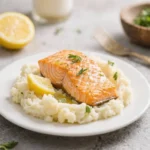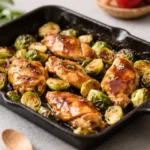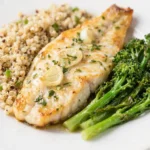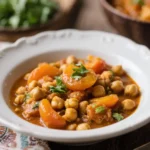Introduction
Lemon Garlic Butter Salmon with Cauliflower Mash is a culinary masterpiece that brings together rich, savory flavors and healthy, wholesome ingredients into one elegant yet approachable dish. Perfect for weeknight dinners or weekend gatherings, this meal balances the delicate richness of salmon with the creamy, velvety texture of cauliflower mash. Light enough to feel nutritious but indulgent enough to satisfy even the most discerning palates, it’s no wonder this recipe has become a favorite among home cooks and food enthusiasts alike. With its vibrant colors, bold aromas, and layers of flavor, every bite delivers a symphony of taste and comfort.
The History
While there isn’t a single origin story for Lemon Garlic Butter Salmon with Cauliflower Mash, the roots of its components span centuries and continents. Salmon has long been a staple in Nordic, Pacific Northwest, and Japanese cuisines, prized for its omega-3 fatty acids and tender, buttery texture. The use of lemon and garlic in seafood preparation dates back to ancient Mediterranean cooking traditions, where citrus was used to brighten rich fish dishes and garlic added depth and antimicrobial benefits. Butter, especially in French cuisine, became a hallmark of luxurious sauces like beurre blanc and beurre monté—techniques that inspire today’s lemon garlic butter sauce.
Cauliflower, on the other hand, originated in the Mediterranean region over 2,000 years ago and was later cultivated widely in India and the Middle East. Its rise as a low-carb alternative to mashed potatoes gained momentum in the late 20th and early 21st centuries, particularly within ketogenic, paleo, and gluten-free diets. As health-conscious eating trends grew, cauliflower mash emerged as a popular substitute, celebrated for its neutral flavor and ability to absorb herbs and fats beautifully. Combining these elements into one harmonious plate reflects modern fusion cooking at its finest—honoring tradition while embracing innovation.
Ingredients Breakdown
Lemon Garlic Butter Salmon:
- Salmon fillets (6–8 oz each): Choose wild-caught Atlantic or sockeye salmon for optimal flavor and nutrient profile. The natural oils enhance moisture and carry the sauce’s flavors deeply into the flesh.
- Unsalted butter: Provides a rich base for the sauce; unsalted allows control over sodium levels. High-quality European-style butter adds extra creaminess due to higher fat content.
- Fresh garlic (minced): Adds pungent aroma and depth. Fresh is essential—pre-minced jarred garlic lacks vibrancy and often contains preservatives.
- Lemon juice (freshly squeezed): Brightens the dish and cuts through the fat. Always use fresh lemons rather than bottled juice for superior acidity and fragrance.
- Lemon zest: Intensifies citrus notes without adding liquid. Use a microplane for fine shreds that distribute evenly.
- Fresh parsley (chopped): Offers herbal freshness and visual appeal. Flat-leaf (Italian) parsley holds up better when cooked.
- Olive oil: Used for searing the salmon skin to achieve crispness without burning the butter-based sauce later.
- Kosher salt and freshly ground black pepper: Essential seasonings that enhance all other flavors.
- Paprika (optional): A pinch adds subtle warmth and color without overpowering the dish.
Cauliflower Mash:
- Whole head of cauliflower or pre-cut florets: Look for firm, white heads with tight curds. Organic is preferable if available.
- Butter or ghee: Enriches the mash and contributes smooth mouthfeel. Ghee offers a nuttier taste and higher smoke point.
- Garlic (whole cloves or minced): Roasting whole cloves before blending creates a sweet, mellow flavor; minced gives sharper bite.
- Heavy cream, half-and-half, or unsweetened almond milk: Adjusts consistency. Cream yields silkier results; plant-based milks keep it dairy-free.
- Nutmeg (a pinch): Complements earthy cauliflower with warm spice—use sparingly to avoid dominance.
- Salt and white pepper: White pepper blends visually and offers a cleaner heat than black pepper in creamy dishes.
- Grated Parmesan or nutritional yeast (optional): Adds umami depth and cheesiness without excess fat.
Step-by-Step Recipe
Preparing the Cauliflower Mash
- Remove leaves and core from one large head of cauliflower. Chop into uniform florets—about 1½-inch pieces—for even cooking.
- Bring a large pot of salted water to a boil. Add cauliflower and cook for 10–12 minutes until very tender when pierced with a fork. Alternatively, steam for 15 minutes to preserve more nutrients.
- Drain thoroughly in a colander and let sit for 2–3 minutes to release excess moisture. Waterlogged mash becomes thin and soupy.
- In a small saucepan, melt 3 tablespoons of butter over medium heat. Add 2 minced garlic cloves and sauté for 1 minute until fragrant but not browned.
- Pour in ¼ cup heavy cream (or alternative), warm gently, and remove from heat. Stir in a pinch of nutmeg, salt, and white pepper.
- Transfer cooked cauliflower to a food processor or high-powered blender. Add the warmed cream mixture. Blend in batches if needed, pulsing first then increasing speed until smooth. Avoid over-processing, which can make the mash gluey.
- Taste and adjust seasoning. For richer flavor, fold in 2 tablespoons grated Parmesan or a tablespoon of nutritional yeast. Keep warm by covering and placing in a low oven (200°F).
Preparing the Lemon Garlic Butter Salmon
- Pat 4 salmon fillets dry with paper towels—this ensures proper searing. Season both sides generously with kosher salt, black pepper, and a light sprinkle of paprika.
- Heat 1 tablespoon olive oil in a large nonstick or stainless steel skillet over medium-high heat until shimmering.
- Place salmon fillets skin-side down in the pan. Press lightly with a spatula for 10 seconds to ensure full contact. Cook undisturbed for 5–6 minutes until skin is crispy and golden.
- Flip carefully using a wide spatula and cook for another 2–4 minutes depending on thickness, aiming for internal temperature of 125–130°F (medium-rare) to 145°F (well done). Transfer to a plate and tent loosely with foil.
- Reduce heat to medium. In the same pan, melt 4 tablespoons of butter. Add 4 cloves of minced garlic and sauté for 30–60 seconds until aromatic.
- Stir in juice of one lemon (about 3 tablespoons) and 1 teaspoon of lemon zest. Simmer for 1–2 minutes to meld flavors and slightly reduce the sauce.
- Optional: Add 1 tablespoon capers or a splash of white wine for complexity. Finish with 2 tablespoons chopped fresh parsley.
- Return salmon to the pan, spooning sauce over the top to glaze. Heat for 1 minute to re-warm if necessary.
Plating
Spoon a generous portion of warm cauliflower mash onto each plate. Place a salmon fillet atop or beside the mash. Generously drizzle with lemon garlic butter sauce and garnish with additional parsley and lemon slices. Serve immediately.
Tips
- Dry the salmon well: Moisture is the enemy of crispy skin. Pat fillets thoroughly before seasoning.
- Don’t crowd the pan: Cook salmon in batches if needed to prevent steaming instead of searing.
- Use a thermometer: An instant-read thermometer ensures perfect doneness. Remove salmon at 125°F—it will continue cooking off-heat.
- Reserve some sauce: Spoon extra lemon garlic butter into a small bowl for guests who want more zest and richness.
- Pre-cook cauliflower ahead: You can boil or steam the cauliflower up to a day in advance and refrigerate. Reheat briefly before blending.
- Avoid blenders with narrow jars: They tend to trap air and leave chunks. A food processor or immersion blender works best.
- Add texture contrast: Top the mash with toasted breadcrumbs or crushed almonds for crunch.
- Infuse the butter: For deeper flavor, simmer butter with rosemary or thyme sprigs before making the sauce (strain before using).
- Rest the salmon: Let it rest for 2–3 minutes after cooking to redistribute juices.
- Balance acidity: If the lemon overwhelms, add a tiny pinch of sugar or honey to round out the sauce.
Variations and Customizations
- Dairy-Free Version: Substitute butter with vegan butter or olive oil, and use coconut milk or cashew cream in the mash.
- Herb Variations: Swap parsley for dill, chives, or tarragon—especially lovely with salmon. Dill pairs exquisitely with lemon.
- Spicy Kick: Add red pepper flakes to the butter sauce or serve with sriracha mayo on the side.
- Mediterranean Twist: Mix olives, sun-dried tomatoes, and feta into the mash or over the salmon.
- Asian-Inspired: Replace lemon with yuzu or rice vinegar, add ginger to the butter, and finish with sesame seeds and green onions.
- Smoked Salmon Option: Use lightly smoked salmon fillets for a deeper, woodsy note.
- Sheet Pan Bake: For easier cleanup, place seasoned salmon and roasted cauliflower florets on a sheet pan. Drizzle with olive oil and bake at 400°F for 15–20 minutes. Finish with warm lemon butter sauce.
- With Peas or Spinach: Stir frozen peas or wilted baby spinach into the cauliflower mash for added color and nutrition.
- Wine-Enhanced Sauce: Deglaze the salmon pan with ¼ cup dry white wine (like Sauvignon Blanc) before adding butter and lemon.
- Gluten-Free Friendly: This entire recipe is naturally gluten-free—just verify labels on any added ingredients like broth or dairy substitutes.
Health Considerations and Nutritional Value
This dish shines not only in flavor but also in nutritional excellence. A typical serving (one 6-oz salmon fillet with ¾ cup cauliflower mash) provides approximately:
- Calories: 450–520 kcal
- Protein: 38–42g – High-quality complete protein supports muscle repair and satiety.
- Fat: 30–35g – Mostly heart-healthy unsaturated fats, including 2–3g of omega-3 fatty acids from salmon, crucial for brain and cardiovascular health.
- Carbohydrates: 8–12g – Low net carbs, ideal for keto, low-carb, or diabetic-friendly diets.
- Fiber: 4–5g – From cauliflower, aiding digestion and gut health.
- Vitamins & Minerals: Rich in vitamin D, B12, selenium, potassium, vitamin C, vitamin K, and folate.
Benefits:
- Heart Health: Omega-3s in salmon reduce inflammation and lower triglycerides.
- Weight Management: High protein and fiber content promote fullness, reducing snacking.
- Anti-Inflammatory Properties: Garlic, lemon, and cruciferous vegetables (cauliflower) contain compounds linked to reduced chronic disease risk.
- Brain Function: Fatty acids support cognitive performance and may reduce neurodegenerative disease risk.
- Bone Health: Vitamin K and calcium (from optional Parmesan) contribute to strong bones.
Cautions:
- Those on blood thinners should monitor vitamin K intake (present in cauliflower and greens); consult a doctor if consuming regularly.
- High-fat versions may not suit individuals with gallbladder issues—consider reducing butter or using lighter dairy.
- Ensure salmon is sustainably sourced to minimize environmental impact and mercury exposure. Opt for wild-caught over farmed when possible.
Ingredients
For the Lemon Garlic Butter Salmon:
- 4 (6–8 oz) skin-on salmon fillets
- 1 tablespoon olive oil
- 4 tablespoons unsalted butter
- 4 cloves garlic, minced
- Juice and zest of 1 large lemon
- 2 tablespoons fresh parsley, chopped
- ½ teaspoon kosher salt (or to taste)
- ¼ teaspoon black pepper
- ¼ teaspoon paprika (optional)
For the Cauliflower Mash:
- 1 large head cauliflower (about 2 lbs), cut into florets
- 3 tablespoons butter or ghee
- 2 cloves garlic, minced
- ¼ cup heavy cream, half-and-half, or unsweetened almond milk
- ¼ teaspoon nutmeg (freshly grated preferred)
- ¾ teaspoon salt (or to taste)
- ¼ teaspoon white pepper
- 2 tablespoons grated Parmesan or 1 tablespoon nutritional yeast (optional)
Directions
- Make the Cauliflower Mash: Boil or steam cauliflower until very tender (10–12 minutes). Drain well and allow to dry slightly.
- In a saucepan, melt butter over medium heat. Sauté garlic for 1 minute until fragrant. Stir in cream, nutmeg, salt, and white pepper. Warm through and remove from heat.
- Transfer cauliflower to a food processor. Add cream mixture and blend until smooth. Fold in Parmesan or nutritional yeast if using. Cover and keep warm.
- Prepare the Salmon: Pat fillets dry and season with salt, pepper, and paprika.
- Heat olive oil in a large skillet over medium-high heat. Place salmon skin-side down and cook 5–6 minutes until skin is crispy.
- Flip and cook an additional 2–4 minutes until desired doneness. Transfer to a plate and cover loosely with foil.
- Reduce heat to medium. Melt butter in the same pan. Add garlic and sauté 30 seconds.
- Stir in lemon juice, zest, and parsley. Simmer 1–2 minutes.
- Return salmon to the pan, spooning sauce over each fillet. Heat 1 minute to glaze.
- To Serve: Plate cauliflower mash, top with salmon, and drizzle with remaining sauce. Garnish with extra parsley and lemon wedges.
FAQ
Can I use frozen salmon?
Yes, but thaw it slowly in the refrigerator overnight for best texture. Never cook frozen salmon directly—it won’t sear properly.
Can I make this recipe ahead of time?
You can prep the cauliflower mash and reheat it with a splash of cream. However, salmon is best cooked fresh. Assemble just before serving for optimal quality.
Why is my cauliflower mash watery?
Insufficient draining or undercooking can cause sogginess. Always drain thoroughly and consider roasting cauliflower instead of boiling to concentrate flavor and reduce moisture.
Can I roast the salmon instead of pan-searing?
Absolutely! Preheat oven to 375°F. Sear skin-side down for 3 minutes, then transfer pan to oven for 8–10 minutes. Finish with sauce.
Is this recipe keto-friendly?
Yes! With minimal carbs and high healthy fats, it fits perfectly within a ketogenic diet framework.
What sides go well with this dish?
Try a simple arugula salad with lemon vinaigrette, sautéed green beans, or roasted asparagus for a balanced plate.
Can I use margarine instead of butter?
Not recommended. Margarine contains water and additives that affect flavor and texture. Stick to real butter or a high-quality plant-based alternative.
How do I store leftovers?
Store salmon and mash separately in airtight containers in the refrigerator for up to 3 days. Reheat gently in a covered skillet or microwave with a damp paper towel to retain moisture.
Can I freeze this dish?
Cauliflower mash freezes well for up to 2 months. Thaw in fridge and re-blend with a little cream. Freezing salmon is not advised—it loses texture and flavor.
How do I know when salmon is cooked?
It should flake easily with a fork and reach an internal temperature of 145°F (63°C) for fully cooked, or 125°F (52°C) for medium-rare. The center should still be slightly translucent if preferred rare.
Summary
Lemon Garlic Butter Salmon with Cauliflower Mash is a gourmet yet easy-to-make meal that combines heart-healthy omega-3s with a creamy, low-carb side dish for a satisfying and nutritious experience. Elegant enough for guests and simple enough for busy nights, it’s a timeless recipe that nourishes both body and soul.










